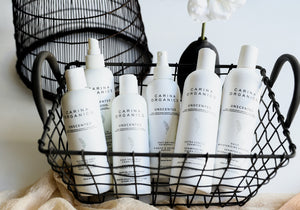Toxins on your skin and in your home
How many personal care products do you use in a day? According to a survey of 2300 people conducted by the non-profit Environmental Working Group, on average, respondents use nine products daily. These contain 126 unique ingredients. One out of every one hundred men, and fully 25 percent of women, surveyed apply 15 or more products each day. Your grooming ritual probably includes shampoo, toothpaste, soap, deodorant, hair conditioner, lip balm, sunscreen, body lotion, shaving products if you’re a man, and makeup if you are a woman. And what about your children? Sunscreen, diaper cream, shampoo, and lotion are common childrens' products. Most people use cosmetics and other personal care items without a second thought, believing that the government oversees their safety. Not so. No health studies or pre-market testing are required for these products.
Our frequent exposures to cosmetics and personal care products raise questions about the potential health risks from the myriad of unregulated ingredients in them. These ingredients migrate into the bodies of the population. For instance, in August 2005, scientists from the University of Rochester reported that prenatal exposure to phthalates — chemicals found in personal care products and other consumer products — could cause the reproductive organs of male infants to develop abnormally (Swan 2005). Studies have shown again and again that hormone systems of wildlife are thrown in disarray by chemicals from personal care products that rinse down drains and into rivers (NIEHS 2010). Why should you be concerned?
Here’s why:
Personal care products are manufactured with 10,500 unique chemical ingredients, some of which are known or suspected carcinogens, toxic to the reproductive system or known to disrupt the endocrine system. Though some companies make personal care products that are safe enough to eat, others choose to use dangerous ingredients like coal tar and formaldehyde, both human carcinogens, and lead acetate, a developmental toxin.
No premarket safety testing is required for the industrial chemicals that go into personal care products or the chemical industry as a whole. According to the Office of Cosmetics and Colors at the federal Food and Drug Administration, “…a cosmetic manufacturer may use almost any raw material as a cosmetic ingredient and market the product without an approval from FDA.” (FDA 2012) The FDA does no systematic reviews of safety, instead authorizing the cosmetics industry to self-police ingredient safety through its Cosmetics Ingredient Review Panel. Over its 36 years, this industry panel has rejected only 11 ingredients as unsafe in cosmetics (CIR, 2012). By contrast, the European Union has banned hundreds of chemicals in cosmetics (European Commission, 2012).
When risky chemicals are used in cosmetics, the stakes are high. These are not trace contaminants that may be measured in parts-per-million or even parts-per-billion as we see in food or water. They are substantial components of the product, just as flour is a primary ingredient in bread. Cosmetic ingredients do not remain on the surface of the skin. They are designed to penetrate, and they do. Scientists have found many common cosmetic ingredients in human tissues, including phthalates in urine, preservatives called parabens in breast tumor tissue, and persistent fragrance components in human fat. Do the concentrations at which they are typically found pose risks? For the most part, those studies have not been done to date, so that question cannot be answered in full at this time. However, a small but growing number of studies serve as scientific red flags (Swan, 2005; Sathyanarayana, 2008; Swan, 2010).*
Helmut Gollner founded Carina over 40 years ago to provide an affordable chemical-free, toxin-free, and environmentally sustainable alternative to these synthetic-based cosmetics, to allow others to get chemicals out of their homes, and lower their impact on the environment. Today Helmut, along with his son Anthony and the Carina team, are expanding to provide further non-toxic alternatives for healthy living and a sustainable future.*
*Excerpt and source courtesy of SKINDEEP http://www.ewg.org/skindeep/2011/04/12



